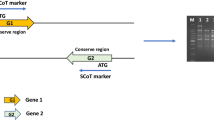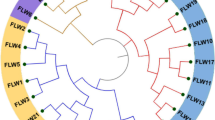Abstract
Camellia sinensis (L.) O. Kuntze is one of the most important non-alcoholic beverage crops in Asian and African countries. In recent years, many green tea cultivars have been released and played an important role in improving the production and quality of tea trees. The objectives of this study were to assess the genetic diversity of the eighteen main green tea cultivars in Zhejiang Province—the most famous green tea-producing area of China—using start codon-targeted (SCoT) markers and to develop a specific sequence-characterized amplified region (SCAR) marker for application in cultivar diagnosis. Thirty-one SCoT primers produced 264 loci, 226 of which were polymorphic. The genetic similarity coefficients among these green tea cultivars ranged from 0.587 to 0.814, indicating that a high level of genetic diversity was present. Both a UPGMA dendrogram and a PCoA plot grouped the tea cultivars into three groups. The partitioning of groups in the UPGMA and PCoA was similar, and much of the clustering was highly consistent with the classification of tea cultivars according to their genetic backgrounds. A unique SCoT band, SCoT4-1649, specific to the tea cultivar ‘Yingshuang,’ was transformed into a SCAR marker. This SCAR marker is highly useful for the identification and germplasm conservation of green tea cultivars.






Similar content being viewed by others
References
Ahmed S, Stepp JR, Orians C, Griffin T, Matyas C, Robbat A, Cash S, Xue DY, Long CL, Unachukwu U, Buckley S, Small D, Kennelly E (2014) Effects of extreme climate events on tea (Camellia sinensis) functional quality validate indigenous farmer knowledge and sensory preferences in tropical China. PLoS ONE 9:e109126
Alikhani L, Rahmani MS, Shabanian N, Badakhshan H, Khadivi-Khub A (2014) Genetic variability and structure of Quercus brantii assessed by ISSR, IRAP and SCoT markers. Gene 552:176–183
Chen L, Zhou ZX, Yang YJ (2007) Genetic improvement and breeding of tea plant (Camellia sinensis) in China: from individual selection to hybridization and molecular breeding. Euphytica 154:239–248
Choi YE, Ahn CH, Kim BB, Yoon ES (2008) Development of species specific AFLP-derived SCAR marker for authentication of Panax japonicus C. A. MEYER. Biol Pharm Bull 31:135–138
Clark K, Karsch-Mizrachi I, Lipman DJ, Ostell J, Sayers EW (2016) GenBank. Nucleic Acids Res 44:D67–72
Collard BCY, Mackill DJ (2009) Start codon targeted (SCoT) polymorphism: a simple, novel DNA marker technique for generating gene-targeted markers in plants. Plant Mol Biol Rep 27:86–93
Correa VR, Mattos VS, Almeida MRA, Santos MFA, Tigano MS, Castagnone-Sereno P, Carneiro RMDG (2014) Genetic diversity of the root- knot nematode Meloidogyne ethiopica and development of a species-specific SCAR marker for its diagnosis. Plant Pathol 63:476–483
Cunha JT, Ribeiro TIB, Rocha JB, Nunes J, Teixeira JA, Domingues L (2016) RAPD and SCAR markers as potential tools for detection of milk origin in dairy products: Adulterant sheep breeds in Serra da Estrela cheese production. Food Chem 211:631–636
Deng L, Liang Q, He X, Luo C, Chen H, Qin Z (2015) Investigation and analysis of genetic diversity of Diospyros germplasms using SCoT molecular markers in Guangxi. PLoS ONE 10:e0136510
Dhole VJ, Reddy KS (2013) Development of a SCAR marker linked with a MYMV resistance gene in mungbean (Vigna radiata L. Wilczek). Plant Breed 132:127–132
Feng SG, He RF, Yang S, Chen Z, Jiang MY, Lu JJ, Wang HZ (2015) Start codon targeted (SCoT) and target region amplification polymorphism (TRAP) for evaluating the genetic relationship of Dendrobium species. Gene 567:182–188
Feng SG, He RF, Yiang MY, Lu JJ, Shen XX, Liu JJ, Wang ZA, Wang HZ (2016b) Genetic diversity and relationships of medicinal Chrysanthemum morifolium revealed by start codon targeted (SCoT) markers. Sci Hortic-Amsterdam 201:118–123
Gavioli EA, Di Mauro AO, Centurion MAPDC, Di Mauro SMZ (2007) Development of SCAR marker linked to stem canker resistance gene in soybean. Crop Breed Appl Biot 7:133–140
Ghosh M, Chezhian P, Sumathi R, Yasodha R (2011) Development of SCAR marker in Casuarina equisetifolia for species authentication. Trees-Struct Funct 25:465–472
Gower JC (1966) Some distance properties of latent root and vector methods used in multivariate analysis. Biometrika 53:325–338
Guo DL, Zhang JY, Liu CH (2012) Genetic diversity in some grape varieties revealed by SCoT analyses. Mol Biol Rep 39:5307–5313
Hao J, Jiao KL, Yu CL, Guo H, Zhu YJ, Yang X, Zhang SY, Zhang L, Feng SG, Song YB, Dong M, Wang HZ, Shen CJ (2018) Development of SCoT-based SCAR marker for rapid authentication of Taxus Media. Biochem Genet 56(3):255–266
Huang L, Lerro C, Yang T, Li J, Qiu J, Qiu WT, He XC, Cui HM, Lv L, Xu RF, Xu XY, Huang H, Liu Q, Zhang Y (2016) Maternal tea consumption and the risk of preterm delivery in urban China: a birth cohort study. BMC Public Health 16:456
Igwe DO, Afiukwa CA, Ubi BE, Ogbu KI, Ojuederie OB, Ude GN (2017) Assessment of genetic diversity in Vigna unguiculata L. (Walp) accessions using inter-simple sequence repeat (ISSR) and start codon targeted (SCoT) polymorphic markers. BMC Genet 18:98
Kanzaki S, Akagi T, Masuko T, Kimura M, Yamada M, Sato A, Mitani N, Ustunomiya N, Yonemori K (2010) SCAR Markers for practical application of marker-assisted selection in persimmon (Diospyros kaki Thunb.) breeding. J Jpn Soc Hortic Sci 79:150–155
Khan M, Pan YB, Iqbal J (2017) Development of an RAPD-based SCAR marker for smut disease resistance in commercial sugarcane cultivars of Pakistan. Crop Prot 94:166–172
Kim DK, Seo SG, Kwon SB, Park YD (2016) Development of a SCAR marker associated with salt tolerance in durum wheat (Triticum turgidum ssp. durum) from a semi-arid region. Genes Genomics 38:939–948
Kumar A, Rodrigues V, Mishra P, Baskaran K, Shukla AK, Shasany AK, Sundaresan V (2018) ISSR-derived species-specific SCAR marker for rapid and accurate authentication of Ocimum tenuiflorum L. Planta Med 84:117–122
Lalitha S (2000) Primer premier 5. Biotech Software & Internet Report 1:270–272
Lee JW, Kim YC, Jo IH, Seo AY, Lee JH, Kim OT, Hyun DY, Cha SW, Bang KH, Cho JH (2011) Development of an ISSR-Derived SCAR Marker in Korean Ginseng Cultivars (Panax ginseng C. A. Meyer). J Ginseng Res 35:52–59
Li L, Fu QL, Achal V, Liu Y (2015) A comparison of the potential health risk of aluminum and heavy metals in tea leaves and tea infusion of commercially available green tea in Jiangxi. China. Environ Monit Assess 187:228
Li FD, He F, Ye XJ, Shen W, Wu YP, Zhai YJ, Wang XY, Lin JF (2016) Tea consumption is inversely associated with depressive symptoms in the elderly: a cross-sectional study in eastern China. J Affect Disord 199:157–162
Lou WP, Sun SL (2013) Design of agricultural insurance policy for tea tree freezing damage in Zhejiang Province, China. Theor Appl Climatol 111:713–728
Luo C, He XH, Chen H, Ou SJ, Gao MP (2010) Analysis of diversity and relationships among mango cultivars using Start Codon Targeted (SCoT) markers. Biochem Syst Ecol 38:1176–1184
Luo C, He XH, Chen H, Hu Y, Ou SJ (2012) Genetic relationship and diversity of Mangifera indica L.: revealed through SCoT analysis. Genet Resour Crop Evol 59:1505–1515
Ma JQ, Zhou YH, Ma CL, Yao MZ, Jin JQ, Wang XC, Chen LA (2010) Identification and characterization of 74 novel polymorphic EST-SSR markers in the tea plant, Camellia sinensis (Theaceae). Am J Bot 97:E153–E156
Marieschi M, Torelli A, Beghe D, Bruni R (2016) Authentication of Punica granatum L.: Development of SCAR markers for the detection of 10 fruits potentially used in economically motivated adulteration. Food Chem 202:438–444
Mukhopadhyay M, Mondal TK, Chand PK (2016) Biotechnological advances in tea (Camellia sinensis [L.] O. Kuntze): a review. Plant Cell Rep 35:255–287
Mulpuri S, Muddanuru T, Francis G (2013) Start codon targeted (SCoT) polymorphism in toxic and non-toxic accessions of Jatropha curcas L. and development of a codominant SCAR marker. Plant Sci 207:117–127
Nei M, Li WH (1979) Mathematical model for studying genetic variation in terms of restriction endonucleases. Proc Natl Acad Sci USA 76:5269–5273
Paran I, Michelmore RW (1993) Development of reliable PCR-based markers linked to downy mildew resistance genes in lettuce. Theor Appl Genet 85:985–993
Raina SN et al (2012) Genetic structure and diversity of India hybrid tea. Genet Resour Crop Evol 59:1527–1541
Rajesh MK, Sabana AA, Rachana KE, Rahman S, Ananda KS, Karun A (2016) Development of a SCoT-derived SCAR marker associated with tall-type palm trait in arecanut and its utilization in hybrid (dwarf x tall) authentication. Indian J Genet Plant Breed 76:119–122
Richero M, Barraco Vega M, Cerdeiras MP, Cecchetto G (2013) Development of SCAR molecular markers for early and late differentiation of Eucalyptus globulus ssp. globulus from E. globulus ssp maidenii. Trees-Struct Funct 27:249–257
Rohlf FJ (2000) NTSYS-PC: numerical taxonomy and multivariate analysis system, version 2.00. Exeter Software, Setauket, New York
Tigano M, de Siqueira K, Castagnone-Sereno P, Mulet K, Queiroz P, dos Santos M, Teixeira C, Almeida M, Silva J, Carneiro R (2010) Genetic diversity of the root-knot nematode Meloidogyne enterolobii and development of a SCAR marker for this guava-damaging species. Plant Pathol 59:1054–1061
Wang YC, Hao XY, Wang L, Bin X, Wang XC, Yang YJ (2016) Diverse Colletotrichum species cause anthracnose of tea plants (Camellia sinensis (L.) O. Kuntze) in China. Sci Rep 6:35287
Xiong FQ, Zhong RC, Han ZQ, Jiang J, He LQ, Zhuang WJ, Tang RH (2011) Start codon targeted polymorphism for evaluation of functional genetic variation and relationships in cultivated peanut (Arachis hypogaea L.) genotypes. Mol Biol Rep 38:3487–3494
Xu YX, Chen W, Ma CL, Shen SY, Zhou YY, Zhou LQ, Chen L (2017) Proteome and acetyl-proteome profiling of Camellia sinensis cv. 'Anji Baicha' during periodic albinism reveals alterations in photosynthetic and secondary metabolite biosynthetic pathways. Front Plant Sci 8:2104
Yang YJ, Liang YR (2014) Zhongguo wuxing xi chashu pingzhong zhi. Shanghai Science and Technology Press China 1:8–256
Yao MZ, Chen L, Liang YR (2008) Genetic diversity among tea cultivars from China, Japan and Kenya revealed by ISSR markers and its implication for parental selection in tea breeding programmes. Plant Breed 127:166–172
Yao MZ, Ma CL, Qiao TT, Jin JQ, Chen L (2012) Diversity distribution and population structure of tea germplasms in China revealed by EST-SSR markers. Tree Genet Genomes 8:205–220
Yu CN, Guo H, Zhang YY, Song YB, Pi EX, Yu CL, Zhang L, Dong M, Zheng BS, Wang HZ, Shen CJ (2017) Identification of potential genes that contributed to the variation in the taxoid contents between two Taxus species (Taxus media and Taxus mairei). Tree Physiol 37(12):1659–1671
Zhao LP, Liu Z, Chen L, Yao MZ, Wang XC (2008) Generation and characterization of 24 novel EST derived microsatellites from tea plant (Camellia sinensis) and cross-species amplification in its closely related species and varieties. Conserv Genet 9:1327–1331
Zhejiang Tea Industry Association (2017) Production and sales analysis of China tea in 2016. China Tea 05:24–25
Zheng H, Li JL, Li HH, Hu GC, Li HS (2014) Analysis of trace metals and perfluorinated compounds in 43 representative tea products from South China. J Food Sci 79:C1123–1129
Acknowledgements
This work was supported by the National Natural Science Foundation of China (No. 31600562), the Central Public-interest Scientific Institution Basal Research Fund (No.1610212018013), the Chinese Academy of Agricultural Sciences through the Agricultural Science and Technology Innovation Program (CAAS-ASTIP-2017-TRICAAS), and the Earmarked Fund for China Agriculture Research System (CARS-019).
Author information
Authors and Affiliations
Corresponding author
Ethics declarations
Conflict of interest
The authors declare that they have no conflict of interest.
Rights and permissions
About this article
Cite this article
Xu, YX., Shen, SY., Chen, W. et al. Analysis of Genetic Diversity and Development of a SCAR Marker for Green Tea (Camellia sinensis) Cultivars in Zhejiang Province: The Most Famous Green Tea-Producing Area in China. Biochem Genet 57, 555–570 (2019). https://doi.org/10.1007/s10528-019-09909-1
Received:
Accepted:
Published:
Issue Date:
DOI: https://doi.org/10.1007/s10528-019-09909-1




